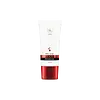What's inside
What's inside
 Key Ingredients
Key Ingredients

 Benefits
Benefits

 Concerns
Concerns

 Ingredients Side-by-side
Ingredients Side-by-side

Water
Skin ConditioningNiacinamide
SmoothingPropylene Glycol
HumectantGlycyrrhiza Glabra Root Extract
BleachingButylene Glycol
HumectantPropanediol
SolventPhenoxyethanol
PreservativeCellulose Gum
Emulsion StabilisingGlycerin
HumectantAcrylates/C10-30 Alkyl Acrylate Crosspolymer
Emulsion StabilisingDisodium EDTA
Triethylene Glycol
MaskingEthylhexylglycerin
Skin ConditioningSodium Hydroxide
BufferingGlutathione
Potassium Sorbate
PreservativeSodium Benzoate
MaskingWater, Niacinamide, Propylene Glycol, Glycyrrhiza Glabra Root Extract, Butylene Glycol, Propanediol, Phenoxyethanol, Cellulose Gum, Glycerin, Acrylates/C10-30 Alkyl Acrylate Crosspolymer, Disodium EDTA, Triethylene Glycol, Ethylhexylglycerin, Sodium Hydroxide, Glutathione, Potassium Sorbate, Sodium Benzoate
Water
Skin ConditioningEthylhexyl Palmitate
EmollientButylene Glycol
HumectantPentylene Glycol
Skin ConditioningCetearyl Alcohol
EmollientPropanediol
SolventDimethicone
EmollientSodium PCA
HumectantStearic Acid
CleansingAluminum Starch Octenylsuccinate
AbsorbentCetyl Alcohol
EmollientPersea Gratissima Oil
Skin ConditioningGlyceryl Stearate
EmollientPEG-100 Stearate
Phenoxyethanol
PreservativeCeteareth-20
CleansingHdi/Trimethylol Hexyllactone Crosspolymer
Parfum
MaskingCarbomer
Emulsion StabilisingEthylhexylglycerin
Skin ConditioningTocopheryl Acetate
AntioxidantSnail Secretion Filtrate
Skin ConditioningSodium Hydroxide
BufferingGlyceryl Linoleate
EmollientBHT
AntioxidantDisodium EDTA
Sodium Lauroyl Lactylate
EmulsifyingTriethylene Glycol
MaskingGlyceryl Oleate
EmollientGlyceryl Palmitate
EmollientSodium Hyaluronate
HumectantEthyl Hexanediol
SolventGlyceryl Linolenate
EmollientCeramide NP
Skin ConditioningHydrolyzed Hyaluronic Acid
HumectantSilica
AbrasiveCeramide AP
Skin ConditioningPhytosphingosine
Skin ConditioningCholesterol
EmollientXanthan Gum
EmulsifyingTocopherol
AntioxidantGlycine Soja Oil
EmollientCeramide EOP
Skin ConditioningWater, Ethylhexyl Palmitate, Butylene Glycol, Pentylene Glycol, Cetearyl Alcohol, Propanediol, Dimethicone, Sodium PCA, Stearic Acid, Aluminum Starch Octenylsuccinate, Cetyl Alcohol, Persea Gratissima Oil, Glyceryl Stearate, PEG-100 Stearate, Phenoxyethanol, Ceteareth-20, Hdi/Trimethylol Hexyllactone Crosspolymer, Parfum, Carbomer, Ethylhexylglycerin, Tocopheryl Acetate, Snail Secretion Filtrate, Sodium Hydroxide, Glyceryl Linoleate, BHT, Disodium EDTA, Sodium Lauroyl Lactylate, Triethylene Glycol, Glyceryl Oleate, Glyceryl Palmitate, Sodium Hyaluronate, Ethyl Hexanediol, Glyceryl Linolenate, Ceramide NP, Hydrolyzed Hyaluronic Acid, Silica, Ceramide AP, Phytosphingosine, Cholesterol, Xanthan Gum, Tocopherol, Glycine Soja Oil, Ceramide EOP
Ingredients Explained
These ingredients are found in both products.
Ingredients higher up in an ingredient list are typically present in a larger amount.
Butylene Glycol (or BG) is used within cosmetic products for a few different reasons:
Overall, Butylene Glycol is a safe and well-rounded ingredient that works well with other ingredients.
Though this ingredient works well with most skin types, some people with sensitive skin may experience a reaction such as allergic rashes, closed comedones, or itchiness.
Learn more about Butylene GlycolDisodium EDTA plays a role in making products more stable by aiding other preservatives.
It is a chelating agent, meaning it neutralizes metal ions that may be found in a product.
Disodium EDTA is a salt of edetic acid and is found to be safe in cosmetic ingredients.
Learn more about Disodium EDTAEthylhexylglycerin (we can't pronounce this either) is commonly used as a preservative and skin softener. It is derived from glyceryl.
You might see Ethylhexylglycerin often paired with other preservatives such as phenoxyethanol. Ethylhexylglycerin has been found to increase the effectiveness of these other preservatives.
Phenoxyethanol is a preservative that has germicide, antimicrobial, and aromatic properties. Studies show that phenoxyethanol can prevent microbial growth. By itself, it has a scent that is similar to that of a rose.
It's often used in formulations along with Caprylyl Glycol to preserve the shelf life of products.
Propanediol is an all-star ingredient. It softens, hydrates, and smooths the skin.
It’s often used to:
Propanediol is not likely to cause sensitivity and considered safe to use. It is derived from corn or petroleum with a clear color and no scent.
Learn more about PropanediolSodium Hydroxide is also known as lye or caustic soda. It is used to adjust the pH of products; many ingredients require a specific pH to be effective.
In small amounts, sodium hydroxide is considered safe to use. However, large amounts may cause chemical burns due to its high alkaline.
Your skin has a natural pH and acid mantle. This acid mantle helps prevent harmful bacteria from breaking through. The acid mantle also helps keep your skin hydrated.
"Alkaline" refers to a high pH level. A low pH level would be considered acidic.
Learn more about Sodium HydroxideTriethylene Glycol is a fragrance.
Water. It's the most common cosmetic ingredient of all. You'll usually see it at the top of ingredient lists, meaning that it makes up the largest part of the product.
So why is it so popular? Water most often acts as a solvent - this means that it helps dissolve other ingredients into the formulation.
You'll also recognize water as that liquid we all need to stay alive. If you see this, drink a glass of water. Stay hydrated!
Learn more about Water